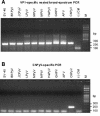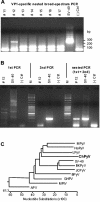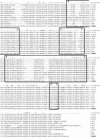Novel polyomavirus detected in the feces of a chimpanzee by nested broad-spectrum PCR
- PMID: 15731285
- PMCID: PMC1075742
- DOI: 10.1128/JVI.79.6.3883-3887.2005
Novel polyomavirus detected in the feces of a chimpanzee by nested broad-spectrum PCR
Abstract
In order to screen for new polyomaviruses in samples derived from various animal species, degenerated PCR primer pairs were constructed. By using a nested PCR protocol, the sensitive detection of nine different polyomavirus genomes was demonstrated. The screening of field samples revealed the presence of a new polyomavirus, tentatively designated chimpanzee polyomavirus (ChPyV), in the feces of a juvenile chimpanzee (Pan troglodytes). Analysis of the region encoding the major capsid protein VP1 revealed a unique insertion in the EF loop of the protein and showed that ChPyV is a distinct virus related to the monkey polyomavirus B-lymphotropic polyomavirus and the human polyomavirus JC polyomavirus.
Figures



Similar articles
-
Characterization of novel polyomaviruses from Bornean and Sumatran orang-utans.J Gen Virol. 2010 Mar;91(Pt 3):653-8. doi: 10.1099/vir.0.017673-0. Epub 2009 Nov 18. J Gen Virol. 2010. PMID: 19923267
-
Detection of chimpanzee polyomavirus-specific antibodies in captive and wild-caught chimpanzees using yeast-expressed virus-like particles.Virus Res. 2011 Feb;155(2):514-9. doi: 10.1016/j.virusres.2010.12.009. Epub 2010 Dec 25. Virus Res. 2011. PMID: 21187117
-
Whole-genome characterization of a novel polyomavirus detected in fatally diseased canary birds.J Gen Virol. 2010 Dec;91(Pt 12):3016-22. doi: 10.1099/vir.0.023549-0. Epub 2010 Aug 25. J Gen Virol. 2010. PMID: 20797969
-
Genome analysis of the new human polyomaviruses.Rev Med Virol. 2012 Nov;22(6):354-77. doi: 10.1002/rmv.1711. Epub 2012 Mar 28. Rev Med Virol. 2012. PMID: 22461085 Review.
-
Polyomaviruses of nonhuman primates: implications for research.Comp Med. 2008 Feb;58(1):51-6. Comp Med. 2008. PMID: 19793457 Free PMC article. Review.
Cited by
-
Genome Sequence of a Central Chimpanzee-Associated Polyomavirus Related to BK and JC Polyomaviruses, Pan troglodytes troglodytes Polyomavirus 1.Genome Announc. 2015 Sep 3;3(5):e00888-15. doi: 10.1128/genomeA.00888-15. Genome Announc. 2015. PMID: 26337874 Free PMC article.
-
Metagenomic and Molecular Detection of Novel Fecal Viruses in Free-Ranging Agile Wallabies.Ecohealth. 2023 Dec;20(4):427-440. doi: 10.1007/s10393-023-01659-2. Epub 2023 Dec 13. Ecohealth. 2023. PMID: 38091182
-
Structural similarity of human papillomavirus E4 and polyomaviral VP4 exhibited by genomic analysis of the common kestrel (Falco tinnunculus) polyomavirus.Vet Res Commun. 2024 Feb;48(1):309-315. doi: 10.1007/s11259-023-10210-1. Epub 2023 Sep 9. Vet Res Commun. 2024. PMID: 37688754 Free PMC article.
-
Extensive Genetic Diversity of Polyomaviruses in Sympatric Bat Communities: Host Switching versus Coevolution.J Virol. 2020 Apr 16;94(9):e02101-19. doi: 10.1128/JVI.02101-19. Print 2020 Apr 16. J Virol. 2020. PMID: 32075934 Free PMC article.
-
Comparing phylogenetic codivergence between polyomaviruses and their hosts.J Virol. 2006 Jun;80(12):5663-9. doi: 10.1128/JVI.00056-06. J Virol. 2006. PMID: 16731904 Free PMC article.
References
-
- Babe, L. M., K. Brew, S. E. Matsuura, and W. A. Scott. 1989. Epitopes on the major capsid protein of simian virus 40. J. Biol. Chem. 264:2665-2671. - PubMed
-
- Brade, L., N. Muller-Lantzsch, and H. zur Hausen. 1981. B-lymphotropic papovavirus and possibility of infections in humans. J. Med. Virol. 6:301-308. - PubMed
-
- Carbone, M., H. I. Pass, L. Miele, and M. Bocchetta. 2003. New developments about the association of SV40 with human mesothelioma. Oncogene 22:5173-5180. - PubMed
Publication types
MeSH terms
Substances
LinkOut - more resources
Full Text Sources
Other Literature Sources
Medical

